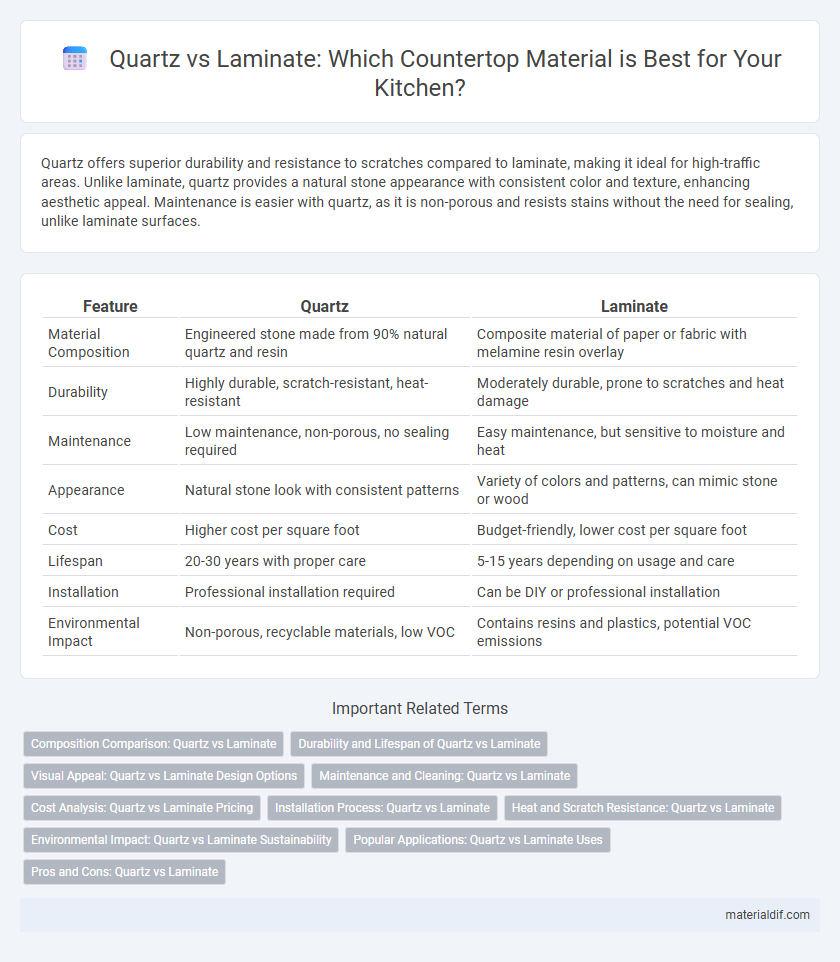Quartz offers superior durability and resistance to scratches compared to laminate, making it ideal for high-traffic areas. Unlike laminate, quartz provides a natural stone appearance with consistent color and texture, enhancing aesthetic appeal. Maintenance is easier with quartz, as it is non-porous and resists stains without the need for sealing, unlike laminate surfaces.
Table of Comparison
| Feature | Quartz | Laminate |
|---|---|---|
| Material Composition | Engineered stone made from 90% natural quartz and resin | Composite material of paper or fabric with melamine resin overlay |
| Durability | Highly durable, scratch-resistant, heat-resistant | Moderately durable, prone to scratches and heat damage |
| Maintenance | Low maintenance, non-porous, no sealing required | Easy maintenance, but sensitive to moisture and heat |
| Appearance | Natural stone look with consistent patterns | Variety of colors and patterns, can mimic stone or wood |
| Cost | Higher cost per square foot | Budget-friendly, lower cost per square foot |
| Lifespan | 20-30 years with proper care | 5-15 years depending on usage and care |
| Installation | Professional installation required | Can be DIY or professional installation |
| Environmental Impact | Non-porous, recyclable materials, low VOC | Contains resins and plastics, potential VOC emissions |
Composition Comparison: Quartz vs Laminate
Quartz countertops consist of approximately 90-95% natural quartz crystals combined with resin and pigments, creating a durable and non-porous surface resistant to scratches and stains. Laminate countertops are composed of a fiberboard core topped with a decorative paper layer sealed under a clear resin, offering a budget-friendly but less heat and scratch-resistant option. The engineered quartz's mineral-rich composition provides superior longevity and aesthetic consistency compared to the synthetic layers of laminate materials.
Durability and Lifespan of Quartz vs Laminate
Quartz surfaces offer superior durability compared to laminate, exhibiting exceptional resistance to scratches, stains, and heat due to their engineered composition of natural quartz and resin. The lifespan of quartz countertops typically exceeds 25 years with minimal maintenance, while laminate surfaces generally last 10 to 20 years, prone to chipping and wear from moisture exposure. Quartz's non-porous nature also ensures higher longevity without delamination or surface degradation common in laminate materials.
Visual Appeal: Quartz vs Laminate Design Options
Quartz offers a wide range of natural stone-inspired patterns and rich, consistent colors due to its engineered composition, providing superior visual appeal compared to laminate. Laminate designs often mimic stone or wood but can lack the depth and texture found in quartz surfaces. The durability of quartz also ensures that its vibrant appearance remains intact over time, unlike laminate, which can fade or peel.
Maintenance and Cleaning: Quartz vs Laminate
Quartz surfaces require minimal maintenance, needing only regular cleaning with mild soap and water to resist stains and scratches effectively. Laminate countertops demand more careful upkeep to prevent water damage and delamination, especially around seams and edges. Quartz's non-porous composition makes it more resistant to bacteria and easier to sanitize compared to the comparatively porous surface of laminate.
Cost Analysis: Quartz vs Laminate Pricing
Quartz countertops typically range from $50 to $150 per square foot, reflecting their durability, non-porous nature, and premium appearance. Laminate surfaces are more budget-friendly, costing between $10 and $40 per square foot, making them a popular choice for cost-conscious renovations. The long-term investment in quartz often outweighs the initial savings of laminate due to quartz's superior lifespan and minimal maintenance requirements.
Installation Process: Quartz vs Laminate
Quartz countertops require professional installation due to their heavy weight and precise cutting needs, often involving specialized tools for fabrication and adhesive setting. Laminate countertops offer a simpler, more DIY-friendly installation process, as they are lighter and can be cut with standard woodworking tools, using adhesive bonding to attach to existing surfaces. Quartz installation tends to be more time-consuming and costly compared to the quicker, more budget-friendly laminate setup.
Heat and Scratch Resistance: Quartz vs Laminate
Quartz countertops exhibit superior heat and scratch resistance compared to laminate, withstanding temperatures up to 300degF without damage, while laminate can warp or discolor under high heat. Quartz's natural hardness, typically rated 7 on the Mohs scale, ensures greater durability against scratches, whereas laminate surfaces, composed of plastic layers, are more prone to gouging and surface damage. These properties make quartz a more robust and long-lasting option for kitchen and bathroom surfaces demanding high heat tolerance and scratch resistance.
Environmental Impact: Quartz vs Laminate Sustainability
Quartz countertops are engineered using natural quartz combined with resin, making them durable yet energy-intensive to produce, resulting in a higher carbon footprint compared to laminate. Laminate surfaces are typically made from layers of paper and plastic resins bonded under heat and pressure, utilizing less energy and often incorporating recycled materials, contributing to a lower environmental impact. However, quartz offers greater longevity and recyclability, potentially offsetting its initial production emissions over the product's lifecycle.
Popular Applications: Quartz vs Laminate Uses
Quartz is widely used for kitchen countertops, bathroom vanities, and backsplashes due to its durability, non-porous surface, and resistance to stains and scratches. Laminate is popular for budget-friendly cabinetry, office furniture, and low-traffic countertops, offering a variety of colors and patterns but with lower heat and scratch resistance. Quartz's versatility in high-use areas contrasts with laminate's suitability for decorative and less demanding applications.
Pros and Cons: Quartz vs Laminate
Quartz countertops offer superior durability, resistance to scratches and stains, and a non-porous surface that inhibits bacterial growth, making them ideal for high-traffic kitchens. Laminate provides a cost-effective alternative with a wide range of designs and colors but is prone to chipping, scratching, and heat damage over time. While quartz requires professional installation and comes at a higher price point, laminate is easier to install and replace, offering flexibility for budget-conscious homeowners.
Quartz vs Laminate Infographic

 materialdif.com
materialdif.com